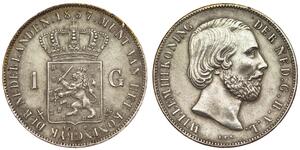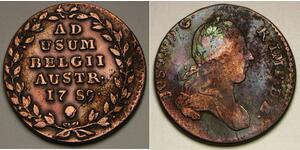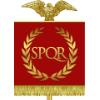1 Plaquette Holy Roman Empire (962-1806) Silver
1753, Liege (Bishopric), Johann Theodor. Rare Silver Plaquette Coin.
Mint Year: 1753
References: KM-152.
Denomination: Plaquette
State: Bishopric of Liége (Belgium)
Diameter: 21mm
Weight: 2.16gm
Material: Silver
The Bishopric of Liège or Prince-Bishopric of Liège was a state of the Holy Roman Empire in the Low Countries in present Belgium. It acquired its status as a prince-bishopric between 980 and 985 when Bishop Notger, who had been the bishop of Liege since 972, acquired the status of Prince-Bishop after he received secular control of the County of Huy from the emperor . The Prince-Bishopric belonged from 1500 on to the Lower Rhenish-Westphalian Circle. It was headed by the Prince-Bishop of Liège. Its territory included most of the present Belgian provinces of Liège and Limburg, and some exclaves in other parts of Belgium and the Netherlands. The capital was Liège (which, as the bishopric, is Lüttich in German and Luik in Dutch). It briefly became a republic (the Liège Republic) from 1789 to 1791, before reverting to a Prince-Bishopric in 1791 then being annexed by France in 1795.
Johann Theodor of Bavaria (3 September 1703 – 27 January 1763), a son of Elector Maximilian II Emanuel of Bavaria and Theresa Kunegunda Sobieska, and a grandson of King John III Sobieski of Poland. In 1743, John Theodore was a cardinal, prince-bishop of Liège from 1744 until 1763, and also prince-bishop of Freising and Regensburg.
Theodor was educated at the University of Ingolstadt in Bavaria and the University of Siena. He was elected bishop of Regensburg on 29 July 1721, at age 17. A little more than four months later, he was elected bishop of Freising, on 5 November 1723.
Even though Theodor was already a bishop-elect, he wasn’t ordained as a priest until 9 April 1730.
Theodor was created a Cardinal-Priest of San Lorenzo in Panisperna on 9 September 1743 by Pope Benedict XIV. He did not participate in the conclave of 1758 following the death of Benedict. He was the last representative of the Wittelsbach family to occupy the bishopric of Liège. In March 1761, shortly after the death of his elder brother Clemens August, Pope Clement XIII rejected his succession as Archbishop and Prince-Elector of Cologne because the pope entertained some doubt as to Theodor’s moral conduct.
Theodor was known as a great hunter, patron of music (he played the violoncello) and theatre, and held a splendid court at Liège. He was said to have had affairs with several women despite his clerical status and was liked by the inhabitants of the bishopric. Asthmatic and tubercular, he gave into the advice of his doctor, a physician named Steppler (a German from Munich), who claimed that his sickness originated from coal vapours. He thus went for regular stays in Germany, though this did not improve his health.
Theodor died on 27 January 1763, in Liège, Belgium. He was buried in Saint-Lambert Cathedral in Liège while his heart was buried in Grace Chapel, Altötting.
(3205 X 1551 pixels, file size: ~716K)
Posted by: anonymous 2024-04-11
1753, Liege (Bishopric), Johann Theodor. Rare Silver Plaquette Coin. PCGS MS-63! Mint Year: 1753 References: KM-152. Denomination: Plaquette State: Bishopric of Liége (Belgium) Condition: Certified and graded by PCGS as MS-63! Diameter: 21mm Weight: 2.16gm Material: Silver The ...
1 Gulden Kingdom of the Netherlands (1815 - ) Silver
group has 5 coins / 5 prices
⇑
2 Liard Austrian Netherlands (1713-1795) Copper
group has 4 coins / 4 prices
⇑

-500-250-GiisHgTyulMAAAGO1VgL5Mrm.jpg)
-300-150-GiisHgTyulMAAAGO1VgL5Mrm.jpg)






-300-150-nRgsHgTyozIAAAGW7ltyjN9I.jpg)

-300-150-N7QKX9ISGfEAAAFX9awaL_VH.jpg)






